PRE2024 3 Group21: Difference between revisions
No edit summary |
No edit summary |
||
| (68 intermediate revisions by 3 users not shown) | |||
| Line 1: | Line 1: | ||
== Group Members == | == ,Group Members == | ||
{| class="wikitable" | {| class="wikitable" | ||
|+ | |+ | ||
| Line 19: | Line 19: | ||
|} | |} | ||
== Problem statement | == Problem statement, goals & motivation == | ||
In today's society waking up early is a necessity for almost every social group, starting from students, to the working population. Despite the universality of the alarm clocks, waking up remains a significant challenge for many individuals. One of the main difficulties of effectively waking up is sleep inertia, a state of sleepiness characterized by impaired cognitive and motor performance immediately after waking up. This phenomenon is shown to affect up to 42% of adolescents but it also persists across various age groups. [7][8] | |||
In previous studies it has been shown that sleep inertia is not only an inconvenience at that moment but it also has serious implications for mental and physical health, safety and productivity during the day. Especially for workers in critical positions like healthcare, transportation and emergency response this situation can compromise their critical decision making and lead to hazardous outcomes [9]. Additionally, research shows that individuals who suffer difficulties to wake up persistently are at higher risk for psychiatric disorders including major depressive disorder and generalized anxiety disorder [11]. | |||
Standard alarm clocks and even more advanced "smart" alarms often can not eliminate the problem of sleep inertia. While some devices use multiple modes of stimulation like, sound, vibration, light, these approaches often rely on passive sensory input and can become ineffective over time as users unconsciously disable them. Recent studies also show that instead of reinforcing wakefulness the usage of multiple wake cues lead to oversaturation, reducing their overall effect due to the brain's limited capacity to process multiple wake cues at once [4][10]. | |||
Recognizing these limitations, our project proposes a new alarm system to reduce the time a person experiences sleep inertia. An interactive alarm clock that requires measurable physical engagement from the user to be turned off. Instead of simply adding extra stimuli to wake the person up, the alarm uses traditional sounds but turning it off requires the user to exert a certain level of grip strength calibrated according to their maximum power during they are awake. Grip strength has been shown to correlate strongly with alertness level and thus, can serve as a proxy for cognitive wakefulness [2][3]. | |||
Lastly, our alarm system uses an AI-Camera system to detect if the user has returned to bed after turning off the alarm. Over time, the device also adapts to the user's routines and responses, improving its ability to intervene when needed. It is also important to bring forward that the system functions without requiring internet connectivity, addressing users' concern about privacy. | |||
== Planning == | == Planning == | ||
| Line 89: | Line 95: | ||
== Approach == | == Approach == | ||
The idea of creating an innovative alarm clock arouse from personal experiences which included times that one or even multiple alarms had been turned off without consciously doing so. To address the limitations of conventional and smart alarm clocks we followed a structured design process, incorporating qualitative and quantitative research, iterative design and technical development. The process consisted of the following phases: | |||
* | * Literature review and research synthesis | ||
* Interviews | ** This phase began by conducting detailed literature review on why this situation occurs, during this research the concept of sleep inertia was found. After finding the main problem, more research was done on why this phenomenon occurs, what are its main effects, how do alarms fail to overcome this problem and what are the different approaches already tried by different products to solve this problem. Key findings highlighted the imperfections of multi-modal alarms, the physiological basis of sleep inertia and the role of grip strength as a measurement for arousal. This research directly supported our initial assumptions and improved some design decisions. | ||
* | * User Interviews and Problem Validation | ||
* The | ** To validate the problem in the real world, we conducted interviews with individuals from part of our target group, students. The interviews focused on waking habits, alarm usage and attitudes toward "smart" alarm systems. Responses helped confirm the presence of alarm related anxiety and the need for more reliable options to wake up. | ||
* | * Concept Development | ||
** There were two core ideas on the design of the project, it needed an active user interaction, rather than a passive one like a button press, to turn off the alarm and a way to detect if the person went back to bed. For the first idea, the paper from Paul R. Jeanneret and Wilse B. Webb [3] showed a reliable way to increase arousal by activating grip strength. The research showed that the muscles around the hand are the weakest upon waking up, and the activation of these muscles requires extra energy and thus increases focus and reduces sleepiness. For the second idea an AI powered camera was chosen to monitor the bed and detect if the person went back to sleep after turning the alarm of | |||
* Prototype Design & Implementation | |||
** The prototype was designed according to our findings from research papers and interviews. The key components included: | |||
*** A PWM-controlled DC motor with a feedback loop for force measurement | |||
*** A 520 Hz square-wave speaker as the alarm sound source | |||
*** A LCS display for user interaction and showing time | |||
*** A current sensor to detect force exertion | |||
*** A camera module for detecting the user's behavior after turning the alarm off | |||
* Behavioral Adaptation | |||
** A simple behavioral learning model was integrated into the system to adapt alarm behavior according to the user interaction history. For example, if the user goes back to sleep repeatedly, the system could increase the resistance of the motor or change the timing of the following alarms. | |||
== State of the Art == | == State of the Art == | ||
'''[https://clocky.com/ CLOCKY]''' - A | There two different changes that can be made on a traditional alarm clock, one would be on the stimuli used to wake the person up and the other on the method used to turn off the alarm. The below products are also divided into these two categories: | ||
<big>'''Stimuli:'''</big> | |||
[https://www.philips.nl/c-p/HF3519_01/smartsleep-wake-up-light '''PHILIPS WAKE UP LIGHT'''] | |||
A sunrise simulation alarm clock that gradually increases light intensity to mimic natural sunlight. This design aims to reduce sleep inertia by aligning with the user’s circadian rhythm and gently easing the person into wakefulness. | |||
'''[https://www.amazon.com/Sonic-Alert-SBB500SS-Extra-Loud-Flashing/dp/B000OOWZUK?th=1 SONIC BOOM]''' | |||
A high-decibel alarm clock (up to 113 dB) designed for heavy sleepers. It comes with a bed-shaker device that vibrates intensely under the mattress or pillow while the alarm sounds. Its multi-sensory approach—sound and physical motion—makes it extremely difficult to ignore. | |||
'''<big>Method on turning the alarm off:</big>''' | |||
'''[https://clocky.com/ CLOCKY]''' | |||
A mobile alarm clock on wheels that jumps off your nightstand and runs around the room when it rings. To stop it, you must physically chase and catch it, promoting full-body movement. | |||
'''[https://gitlab.com/derSchabi/Terminightor TERMINIGHTOR]''' | |||
An Android app that requires users to scan a pre-registered NFC tag located somewhere away from the bed. This enforces getting up and moving to stop the alarm. | |||
'''[https://github.com/sweakpl/qralarm-android QRALARM]''' | |||
This app requires scanning a specific QR code to silence the alarm. Users can place the code in another room, ensuring they must get out of bed to deactivate it. | |||
'''[http://kogcreations.com/ I CAN'T WAKE UP!]''' | |||
A multi-tasking alarm app that forces users to complete one or more challenges—like solving math problems, memory games, or pattern recognition puzzles—before it will shut off, ensuring cognitive engagement. | |||
'''[https://www.thisiswhyimbroke.com/dumbbell-alarm-clock/ DUMBELL ALARM]''' | |||
An alarm clock that doubles as a dumbbell. It requires the user to perform a number of reps (e.g., 30 curls) to deactivate it, effectively incorporating physical exercise as a wake-up method. | |||
==Important Research == | |||
Description and impacts of some of the more relevant pieces of research for the project. | |||
{| class="wikitable" | |||
|+ | |||
! Refrence Number | |||
!Relevant Results | |||
!Impact | |||
|- | |||
|[1] | |||
|Snoozing is defined as the use of multiple consecutive alarms in order to wake up. The study concludes that this type of behavior is quite prevalent amongst students and working individuals. It is also noted that individuals usually set up multiple alarms one after the other as a result of anxiety in regards to waking up. | |||
|Initial confirmation of some of the initial assumptions. | |||
|- | |||
| [3] | |||
| Study highlight a 13% variation in grip strength in between a wakeful state, compared to just having been woken up. | |||
| This variation inspired the use of mechanical force threshold as a means of turning the alarm off. It also representing a more demanding type of movement as opposed to a simple tap or swiping, in the case of smartphones. | |||
|- | |||
|[4] | |||
|Modes in an alarm clock represents the avenues that the device takes in order to wake the user up (sound, light, temperature). Overall it is noted that the effects of stacking multiple of these strategies together usually have a saturating effect after the second mode. | |||
|Guided the design process more in the direction of "how the user should turn off the alarm" as less in the ways of "how the alarm should wake up the user". In the end it was decided to only use a sound in order to wake up the user, all of the focus being on the alarm making sure the user is properly woken up and doesn't go back to bed. | |||
|} | |||
==Interview Questions== | |||
Questions about waking up: | |||
#Do you have trouble waking up in the morning? | |||
#Have you ever experienced turning off your alarm clock in the morning and going back to sleep? | |||
#If yes, have you ever closed an alarm in the morning and going back to sleep without remembering it? | |||
#Have you ever missed classes / were late for university / work because of this? | |||
# Have you tried using special apps that make you solve an exercise or take some steps for the alarm to turn off? | |||
#If yes how well did they work for you? | |||
# Do you have a good sleep schedule ? | |||
Questions about the product: | |||
#Would you be interested in buying a smart alarm clock that would help you wake up in the morning? | |||
#How much would you be willing to pay for it? | |||
#If the device is not connected to the internet with what types of sensors would you be comfortable? (e.g. camera, distance sensors, microphone etc.) | |||
#Would you want it to track your sleeping quality and wake up times? | |||
#Would you be comfortable with the device adapting its behavior based on how you interact with it? | |||
== User study== | |||
During our interviews on students at the university, we have noticed that most of the participants experience having trouble waking up in the morning, especially the ones that must commute and have to wake up very early. More than three quarters of them experienced sleep inertia, which they consider it is a reason of anxiety and worrying, especially when they have a morning flight or exam. Most of the people interviewed have tried using dedicated phone applications to help with waking up, however, very few of them have found them to be useful. | |||
More than half of them responded positively when asked if they would buy a smart alarm clock, and the €30 price mark was the common answer for how much they would be willing to spend for it. Considering that the device is not connected to internet, the students responded that hey are comfortable with most of the sensors such as cameras and microphones. | |||
===Personas=== | |||
[[File:Screenshot_2025-03-23_115700.png|frameless|1497x1497px|center]] | |||
[[File:Screenshot_2025-03-23_120231.png|frameless|1471x1471px|center]] | |||
- | |||
== | ==Product Requirements== | ||
{| class="wikitable" | |||
|+ | |||
!Id | |||
! Requirement Description | |||
|- | |||
|R-01 | |||
|The alarm clock shall be able to be programmed at what time it should wake up the user. | |||
|- | |||
|R-02 | |||
|The alarm clock time shall be able to be programmed by the user. | |||
|- | |||
|R-03 | |||
|The alarm clock shall be able to emit a sound loud enough to wake up the user. | |||
|- | |||
|R-04 | |||
|The alarm clock shall be able to be stopped by the means of the user exerting any kind of force agains an electromechanical device. | |||
|- | |||
|R-05 | |||
|The point at which the user's attempt to stop the alarm should be determined by the current draw to the electromechanical device. | |||
|- | |||
| R-06 | |||
|The user shall be able to set the maximum force the electromechanical device is allowed to exert. | |||
|- | |||
|R-07 | |||
|The alarm clock should be able to impose multiple cycles of the user overpowering the mechanical device. | |||
|- | |||
|R-08 | |||
|The alarm clock shall have a way of determining if the user has gone back to bed. | |||
|- | |||
|R-09 | |||
| The alarm clock shall keep track of user behaviour over time in order to maximise its ability to wake up the user and the experience of the user itself. | |||
|- | |||
|R-10 | |||
|The alarm clock shall be powered by the means of a main's connection. | |||
|- | |||
|R-11 | |||
|The overall alarm clock should not cost morethat 35 Euros. | |||
|- | |||
|R-12 | |||
|The user shall be able to provide feedback to the alarm clock in case of failure to wake up. | |||
|- | |||
|R-13 | |||
|The alarm clock shall have a time threshold after deactivation after which it will no longer check if the user is bed or not. | |||
|- | |||
| R-14 | |||
|The alarm clock threshold for stopping to actively check for the user's presence in bed should be able to be changed based on data accumulated by the system. | |||
|} | |||
== References == | ==Design == | ||
===General Description=== | |||
[[File:Micrometal.png|thumb|320x320px|Example of a micro metal DC motor with a gear box at the end that reduces the gear ratio.]] | |||
The important additions to a classical alarm clock that this design offers are represented in the way that the devices is able to actively check whether the user is in bed and its ability to adapt based on the user's behavior and the manner in which the alarm itself is turned off. Starting from the ground up, the first step was to move away from the simple motions used to turn off classical alarms, let them be in the form of a phone app or a more classical bedside digital/analog one. This was done in the form of having the user utilize a threshold amount of force in order to turn the alarm off. The intended result is to, once, reduce user anxiety in regards to the possibility of not waking up [1], and second, in order to raise the probability of the user having to be in a more awoken state in order to successfully turn the alarm off [3]. The next step was the introduction of a way in which the alarm clock can tell if the user has gone back to bed and act accordingly, based on previous data and negative user feedback. | |||
=== Actuators=== | |||
====Speaker==== | |||
The main role of the speaker is standard in the sense of an alarm clock, as it is used in order to generate a sound meant to wake the user up. The generated sound was chosen to be a 520Hz square wave signal due to the fact that: it is a simple sound which can be more accurately tested in an isolated environment and thus obtain a better appreciation for its efficiency in waking the user up and that from a multiple set of such sounds it is the one that offers the best performance in this context [5]. | |||
==== Micro-metal DC Motor==== | |||
The motor is used, paired with a way to measure absolute positions (in this case a potentiometer), to provide the counteractive force in the "turning off" procedure of the alarm. An alternative would have been to use some kind of mechanical system to gauge user force, however with the need of commensurability of the amount of force threshold and the ability to emulate various kinds of haptic feedback through the feedback loop, the choice of using an electromechanical device in a closed loop system was chosen. A micro-metal DC motor with a 100:1 gear ratio was as a result of its compact form and output torque. The motor is connected to a potentiometer through a set of gears with a 1:1 gear ration. The force applied by the DC motor is controlled through a PWM signal generated by the internal computer/mictrocontroller. The nice simplicity of the setup is that the system in which the duty cycle of the input voltage is the input the output torque of the motor is the output represents a linear system. This can be deduced by first having the motor only apply static force (as that is how it is going to be used), thus the voltage drop over the motor winding will be 0. | |||
[[File:Equation1.png|center|frameless|423x423px]]This current through the motor is also directly proportional to the torque generated. | |||
[[File:TorqueDC.png|center|frameless|233x233px]] | |||
Since the current is also directly proportional to the duty cycle of the PWM signal, if the PWM signal is also controlled by a proportional controller then the force curve is going to be that of a spring. This is rather desirable as it provides good haptic feedback to the user and the device generating gradual torque is an indicator to the user that everything works as it should. | |||
[[File:Untitled Diagram(1)(1).drawio.png|center|frameless|827x827px]] | |||
[[File:Section.png|thumb|612x612px|Example of a sectioned image by the AI model.]] | |||
LCD Display | |||
The LCD display is used in order to display the current time and display additional information in regards to what operation the user is performing a a certain moment, in relation to the device (setting a new alarm, feedback that the alarm has been deactivated etc.). | |||
=== Sensors=== | |||
The design features two main sensing inputs. The first one is a standard digital camera which will be pointed from above at the user's bed in order to check if the user is sleeping. This detection is done by first acquiring an image from the digital camera and using Tensorflow's [https://blog.tensorflow.org/2019/11/updated-bodypix-2.html BodyPix] computer vision model to detect the visible sections of the user's body. The model does not require full vision of the entire human body and is able to detect sections of it. Note that this does however limit the probability of success of the measurement as it requires a minimal area of the user's body to be visible (e.g. such as the head), which may cause false negatives in the cases where the user is completely covered by the blanket. On the other hand the system should be quite resilient to false positives which have the capacity to worsen the user experience much more than compared with the false negatives. Furthermore, some geometrical analysis will be performed on the resulted detected areas. In such an analysis the content within the area is not taken into account but rather the size and shape of it. | |||
[[File:CameraREVR.png|center|frameless|878x878px]] | |||
As displayed in the diagram above. The results of the detection are then used in relation to previous measurements, the amount of time the user stays in bed after the alarm has ringed and determines if the alarm should be turned on again to have the user leave the bed. By default the alarm clock waits 20 seconds after the alarm has been turned off to check whether the user has gone back to bed. The trade-off in the case of the time interval is in regards to not letting the user fall asleep for too much, in the event that they do go back to bed, and for the time interval not to be inconvenient, if one would have had to get out of bed in 3 seconds it would not be such a pleasant experience. The time interval is then changed based on how much can the user be trusted. If the device notices a track record of not going back to bed, or just not leaving it at all, then it try to increase this time interval. If the opposite is true, the user likes to go back to bed, then it will decrease this time interval.[[File:Untitled Diagram(2).drawio..png|center|frameless|661x661px]] | |||
==Prototype Gallery == | |||
[[File:Prot.jpg|center|thumb|750x750px|Front view of the prototype. The camera and turn knob can be seen from this point of view. The gear wheels transmit the movement to the position encoder.]] | |||
[[File:Topviewp.jpg|center|thumb|751x751px|Top view of the prototype. From this point of view the LCD screen with ]] | |||
[[File:Front.png|center|thumb|327x327px|Menu of the alarm clock.]] | |||
[[File:Cal.png|center|thumb|740x740px|Calibration procedure of the device. The arrow indicates how far the knob has been turned. The top text indicates the current instruction to the user.]] | |||
[[File:Scenarioex.png|center|thumb|758x758px|Example scenario of the user turning off the alarm.]] | |||
[[File:Internals1.png|center|thumb|1264x1264px|The internal construction of the prototype.]] | |||
==Experimental Results== | |||
{| class="wikitable" | |||
|+ | |||
!Point of Interest | |||
!Results | |||
|- | |||
|Sound effectiveness. | |||
|The sound is capable of waking the user up. However it seems to be quite an abrupt way of waking up. | |||
|- | |||
|Effectiveness of the knob. | |||
|The added effort in turning the alarm off does seem to a have some impact. The small excericse also increases blood flow in the hand that was used. | |||
|- | |||
|Effectiveness of the AI visual system. | |||
|The system did manage to determine if the person is in bed in most test scenarios. No actual cases of the user going back to bed have been recorded. There is also a type of "panopticon" effect present as the user actively knows that the device would normally monitor them afterwards. Furthermore, there were problems with a certain pillow pattern, more specifically if the pillow features a set of stripes then there is a chance that the model will classify that as a human body part. | |||
|- | |||
|Effectiveness of visual input. | |||
|The visual identifiers/feedback was understood by people who initially saw it for the first time. However the calibration procedure did impose some difficulties when using it for the first time. | |||
|} | |||
[[File:Pillow.jpg|center|thumb|577x577px|The pillow which has been classified as a human by the AI model.]] | |||
==Future Improvements == | |||
A list of possible future improvements in future iterations. | |||
1) A purpose built computer vision AI model would be required. One that was specifically trained on a relevant dataset. This is due to the fact that while the TfBodyPix model is capable of identifying body parts in an image, it is more so made to do it in more common environments where a person would be standing up, as opposed to lying in bed. | |||
2) A normal camera is not well suited for this task as it requires a light source in order to operate. Moreover, if the user decides to put a blanket over them this also makes the task of the computer vision model much more difficult. Ideally a thermal camera would be employed as it can directly track the heat signature of the person in bed without requiring a light source or a direct line of sight. | |||
3) The position reading device while working in the context of the prototype is not appropriate for the task as it limits the angles at which the knob can be rotated. A better approach would have been to use a servo motor absolute position encoder which does not limit rotation. | |||
4) A DC motor, while offering the linear relation between torque and current, is susceptible to wear over time. Ideally a type of linear actuator or brush-less DC motor would be used in its place. | |||
5) The user interface of the prototype is severely limited, it only offering just enough flexibility for testing purposes. A more modern/customizable choice can be made for its place. | |||
6) The prototype is only capable of emitting one sound. This represents a limitation which could be easily overcome with future work. | |||
7) The position sensor should be integrated within the actuator/motor for a more smaller design. | |||
8) A real time clock should be implemented in order to keep track of time even if the device is unplugged. | |||
9) A battery could be included in order to have the device still function in the event of a power outage. | |||
10) A more gradual/calm alarm sound should be employed. | |||
==References== | |||
[1] Stephen M. Mattingly, Gonzalo Martinez, Jessica Young, Meghan K. Cain, Aaron Striegel, (2022), Snoozing: an examination of a common method | [1] Stephen M. Mattingly, Gonzalo Martinez, Jessica Young, Meghan K. Cain, Aaron Striegel, (2022), Snoozing: an examination of a common method | ||
of waking, Sleep Research Society | of waking, Sleep Research Society | ||
[2] Keiko Ogawa, Emi Kaizuma‑Ueyama, Mitsuo Hayashi, (2022), Effects of using a snooze alarm on sleep | |||
inertia after morning awakening, Journal of Physiological Anthropology | |||
[3] PAUL R. JEANNERET, WILSE B. WEBB, (1963), Strength of grip on arousal from full night's sleep, Perceptual and Motor Skills | |||
[4] Carolina Campanella, Kunjoon Byun, Araliya Senerat, Linhao Li, Rongpeng Zhang, Sara Aristizabal, Paige Porter, Brent Bauer, (2024), The Efficacy of a Multimodal Bedroom-Based ‘Smart’ Alarm System on Mitigating the Effects of Sleep Inertia, Clocks & Sleep. | |||
[5] Dorothy Bruck, Ian Thomas, (2007), Waking effectiveness of alarm (auditory, visual and tactile) for adults who are hard of hearing | |||
[6] Eino Hietanen, (1984), Cardiovascular responses to static exercise, Scandinavian Journal of Work Environment & Health | |||
[7] Trotti, L. M. (2017). Waking Up is the Hardest Thing I Do All Day: Sleep Inertia and Sleep Drunkenness. Sleep Medicine Reviews | |||
[8] Dinges, D. F., & Weaver, T. E. (2019). Sleep Inertia: Current Insights. Nature and Science of Sleep | |||
[9] Russo, M. et al. (2023). The Danger of Grogginess: Sleep Inertia in Professional Settings. Clocks & Sleep | |||
[10] McFarlane, S. J., et al. (2020). Alarm Sounds and Their Effect on Sleep Inertia. | |||
[11] Maynard, D. et al. (2024). Chronotype, Wake Difficulty and Psychiatric Risk: A UK Biobank Analysis. | |||
==Work distribution== | |||
{| class="wikitable" | |||
|+ | |||
!Name | |||
! Week 1 | |||
!Week 2 | |||
!Week 3 | |||
!Week 4 | |||
!Week 5 | |||
! Week 6 | |||
!Week 7 | |||
|- | |||
|Stefan Baltac | |||
|16 hours: | |||
Studying research papers | |||
Updating the wiki page | |||
|14 hours: | |||
Studying research papers | |||
Writing interview questions | |||
|16 hours: | |||
Studying research papers | |||
Conducting interviews | |||
Updating the wiki page | |||
|20 hours: | |||
Analyzing the interview results | |||
Deciding the product requirements | |||
Designing and building the prototype | |||
Updating the wiki page | |||
| 20 hours: | |||
Designing and building the prototype | |||
|19 hours: | |||
Designing, building and testing the prototype | |||
Updating the wiki page | |||
|15 hours: | |||
Working on the final presentation | |||
Filming demo | |||
Updating the wiki page | |||
|- | |||
|Octavian Astefanei | |||
|15 hours: | |||
Studying research papers | |||
Updating the wiki page | |||
|16 hours: | |||
Studying research papers | |||
Writing interview questions | |||
|16 hours: | |||
Studying research papers | |||
Conducting interviews | |||
Updating the wiki page | |||
| 19 hours: | |||
Analyzing the interview results | |||
Deciding the product requirements | |||
Updating the wiki page | |||
|14 hours: | |||
Updating wiki page | |||
|18 hours: | |||
Designing, building and testing the prototype | |||
Updating the wiki page | |||
|15 hours: | |||
Working on the final presentation | |||
Filming demo | |||
Updating the wiki page | |||
|- | |||
|Kerim Gjergjizi | |||
|12 hours: | |||
Studying research paper | |||
|10 hours: | |||
Studying research papers | |||
|14 hours: | |||
Studying research papers | |||
Conducting interviews | |||
|12 hours: | |||
Analyzing interview results | |||
Deciding on product design | |||
| | |||
|12 hours: | |||
Updating wiki | |||
Help on building the prototype | |||
|16 hours: | |||
Working on the final presentation | |||
Finishing up the wiki page | |||
|} | |||
Latest revision as of 19:06, 9 April 2025
,Group Members
| Member | Student Number | Program |
|---|---|---|
| Stefan Baltac | 1808877 | Electrical Engineering |
| Octavian Astefanei | 1836374 | Electrical Engineering |
| Kerim Gjergjizi | 1813420 | Electrical Engineering |
Problem statement, goals & motivation
In today's society waking up early is a necessity for almost every social group, starting from students, to the working population. Despite the universality of the alarm clocks, waking up remains a significant challenge for many individuals. One of the main difficulties of effectively waking up is sleep inertia, a state of sleepiness characterized by impaired cognitive and motor performance immediately after waking up. This phenomenon is shown to affect up to 42% of adolescents but it also persists across various age groups. [7][8]
In previous studies it has been shown that sleep inertia is not only an inconvenience at that moment but it also has serious implications for mental and physical health, safety and productivity during the day. Especially for workers in critical positions like healthcare, transportation and emergency response this situation can compromise their critical decision making and lead to hazardous outcomes [9]. Additionally, research shows that individuals who suffer difficulties to wake up persistently are at higher risk for psychiatric disorders including major depressive disorder and generalized anxiety disorder [11].
Standard alarm clocks and even more advanced "smart" alarms often can not eliminate the problem of sleep inertia. While some devices use multiple modes of stimulation like, sound, vibration, light, these approaches often rely on passive sensory input and can become ineffective over time as users unconsciously disable them. Recent studies also show that instead of reinforcing wakefulness the usage of multiple wake cues lead to oversaturation, reducing their overall effect due to the brain's limited capacity to process multiple wake cues at once [4][10].
Recognizing these limitations, our project proposes a new alarm system to reduce the time a person experiences sleep inertia. An interactive alarm clock that requires measurable physical engagement from the user to be turned off. Instead of simply adding extra stimuli to wake the person up, the alarm uses traditional sounds but turning it off requires the user to exert a certain level of grip strength calibrated according to their maximum power during they are awake. Grip strength has been shown to correlate strongly with alertness level and thus, can serve as a proxy for cognitive wakefulness [2][3].
Lastly, our alarm system uses an AI-Camera system to detect if the user has returned to bed after turning off the alarm. Over time, the device also adapts to the user's routines and responses, improving its ability to intervene when needed. It is also important to bring forward that the system functions without requiring internet connectivity, addressing users' concern about privacy.
Planning
| Task | Responsible | Week 1 | Week 2 | Week 3 | Week 4 | Week 5 | Week 6 | Week 7 |
|---|---|---|---|---|---|---|---|---|
| Research | Stefan, Octavian, Kerim | X | X | X | ||||
| Interviews | Stefan, Octavian, Kerim | X | X | |||||
| Concept | Octavian, Kerim | X | ||||||
| Development | Stefan | X | ||||||
| Prototyping | Stefan, Octavian | X | X |
Approach
The idea of creating an innovative alarm clock arouse from personal experiences which included times that one or even multiple alarms had been turned off without consciously doing so. To address the limitations of conventional and smart alarm clocks we followed a structured design process, incorporating qualitative and quantitative research, iterative design and technical development. The process consisted of the following phases:
- Literature review and research synthesis
- This phase began by conducting detailed literature review on why this situation occurs, during this research the concept of sleep inertia was found. After finding the main problem, more research was done on why this phenomenon occurs, what are its main effects, how do alarms fail to overcome this problem and what are the different approaches already tried by different products to solve this problem. Key findings highlighted the imperfections of multi-modal alarms, the physiological basis of sleep inertia and the role of grip strength as a measurement for arousal. This research directly supported our initial assumptions and improved some design decisions.
- User Interviews and Problem Validation
- To validate the problem in the real world, we conducted interviews with individuals from part of our target group, students. The interviews focused on waking habits, alarm usage and attitudes toward "smart" alarm systems. Responses helped confirm the presence of alarm related anxiety and the need for more reliable options to wake up.
- Concept Development
- There were two core ideas on the design of the project, it needed an active user interaction, rather than a passive one like a button press, to turn off the alarm and a way to detect if the person went back to bed. For the first idea, the paper from Paul R. Jeanneret and Wilse B. Webb [3] showed a reliable way to increase arousal by activating grip strength. The research showed that the muscles around the hand are the weakest upon waking up, and the activation of these muscles requires extra energy and thus increases focus and reduces sleepiness. For the second idea an AI powered camera was chosen to monitor the bed and detect if the person went back to sleep after turning the alarm of
- Prototype Design & Implementation
- The prototype was designed according to our findings from research papers and interviews. The key components included:
- A PWM-controlled DC motor with a feedback loop for force measurement
- A 520 Hz square-wave speaker as the alarm sound source
- A LCS display for user interaction and showing time
- A current sensor to detect force exertion
- A camera module for detecting the user's behavior after turning the alarm off
- The prototype was designed according to our findings from research papers and interviews. The key components included:
- Behavioral Adaptation
- A simple behavioral learning model was integrated into the system to adapt alarm behavior according to the user interaction history. For example, if the user goes back to sleep repeatedly, the system could increase the resistance of the motor or change the timing of the following alarms.
State of the Art
There two different changes that can be made on a traditional alarm clock, one would be on the stimuli used to wake the person up and the other on the method used to turn off the alarm. The below products are also divided into these two categories:
Stimuli:
A sunrise simulation alarm clock that gradually increases light intensity to mimic natural sunlight. This design aims to reduce sleep inertia by aligning with the user’s circadian rhythm and gently easing the person into wakefulness.
A high-decibel alarm clock (up to 113 dB) designed for heavy sleepers. It comes with a bed-shaker device that vibrates intensely under the mattress or pillow while the alarm sounds. Its multi-sensory approach—sound and physical motion—makes it extremely difficult to ignore.
Method on turning the alarm off:
A mobile alarm clock on wheels that jumps off your nightstand and runs around the room when it rings. To stop it, you must physically chase and catch it, promoting full-body movement.
An Android app that requires users to scan a pre-registered NFC tag located somewhere away from the bed. This enforces getting up and moving to stop the alarm.
This app requires scanning a specific QR code to silence the alarm. Users can place the code in another room, ensuring they must get out of bed to deactivate it.
A multi-tasking alarm app that forces users to complete one or more challenges—like solving math problems, memory games, or pattern recognition puzzles—before it will shut off, ensuring cognitive engagement.
An alarm clock that doubles as a dumbbell. It requires the user to perform a number of reps (e.g., 30 curls) to deactivate it, effectively incorporating physical exercise as a wake-up method.
Important Research
Description and impacts of some of the more relevant pieces of research for the project.
| Refrence Number | Relevant Results | Impact |
|---|---|---|
| [1] | Snoozing is defined as the use of multiple consecutive alarms in order to wake up. The study concludes that this type of behavior is quite prevalent amongst students and working individuals. It is also noted that individuals usually set up multiple alarms one after the other as a result of anxiety in regards to waking up. | Initial confirmation of some of the initial assumptions. |
| [3] | Study highlight a 13% variation in grip strength in between a wakeful state, compared to just having been woken up. | This variation inspired the use of mechanical force threshold as a means of turning the alarm off. It also representing a more demanding type of movement as opposed to a simple tap or swiping, in the case of smartphones. |
| [4] | Modes in an alarm clock represents the avenues that the device takes in order to wake the user up (sound, light, temperature). Overall it is noted that the effects of stacking multiple of these strategies together usually have a saturating effect after the second mode. | Guided the design process more in the direction of "how the user should turn off the alarm" as less in the ways of "how the alarm should wake up the user". In the end it was decided to only use a sound in order to wake up the user, all of the focus being on the alarm making sure the user is properly woken up and doesn't go back to bed. |
Interview Questions
Questions about waking up:
- Do you have trouble waking up in the morning?
- Have you ever experienced turning off your alarm clock in the morning and going back to sleep?
- If yes, have you ever closed an alarm in the morning and going back to sleep without remembering it?
- Have you ever missed classes / were late for university / work because of this?
- Have you tried using special apps that make you solve an exercise or take some steps for the alarm to turn off?
- If yes how well did they work for you?
- Do you have a good sleep schedule ?
Questions about the product:
- Would you be interested in buying a smart alarm clock that would help you wake up in the morning?
- How much would you be willing to pay for it?
- If the device is not connected to the internet with what types of sensors would you be comfortable? (e.g. camera, distance sensors, microphone etc.)
- Would you want it to track your sleeping quality and wake up times?
- Would you be comfortable with the device adapting its behavior based on how you interact with it?
User study
During our interviews on students at the university, we have noticed that most of the participants experience having trouble waking up in the morning, especially the ones that must commute and have to wake up very early. More than three quarters of them experienced sleep inertia, which they consider it is a reason of anxiety and worrying, especially when they have a morning flight or exam. Most of the people interviewed have tried using dedicated phone applications to help with waking up, however, very few of them have found them to be useful.
More than half of them responded positively when asked if they would buy a smart alarm clock, and the €30 price mark was the common answer for how much they would be willing to spend for it. Considering that the device is not connected to internet, the students responded that hey are comfortable with most of the sensors such as cameras and microphones.
Personas
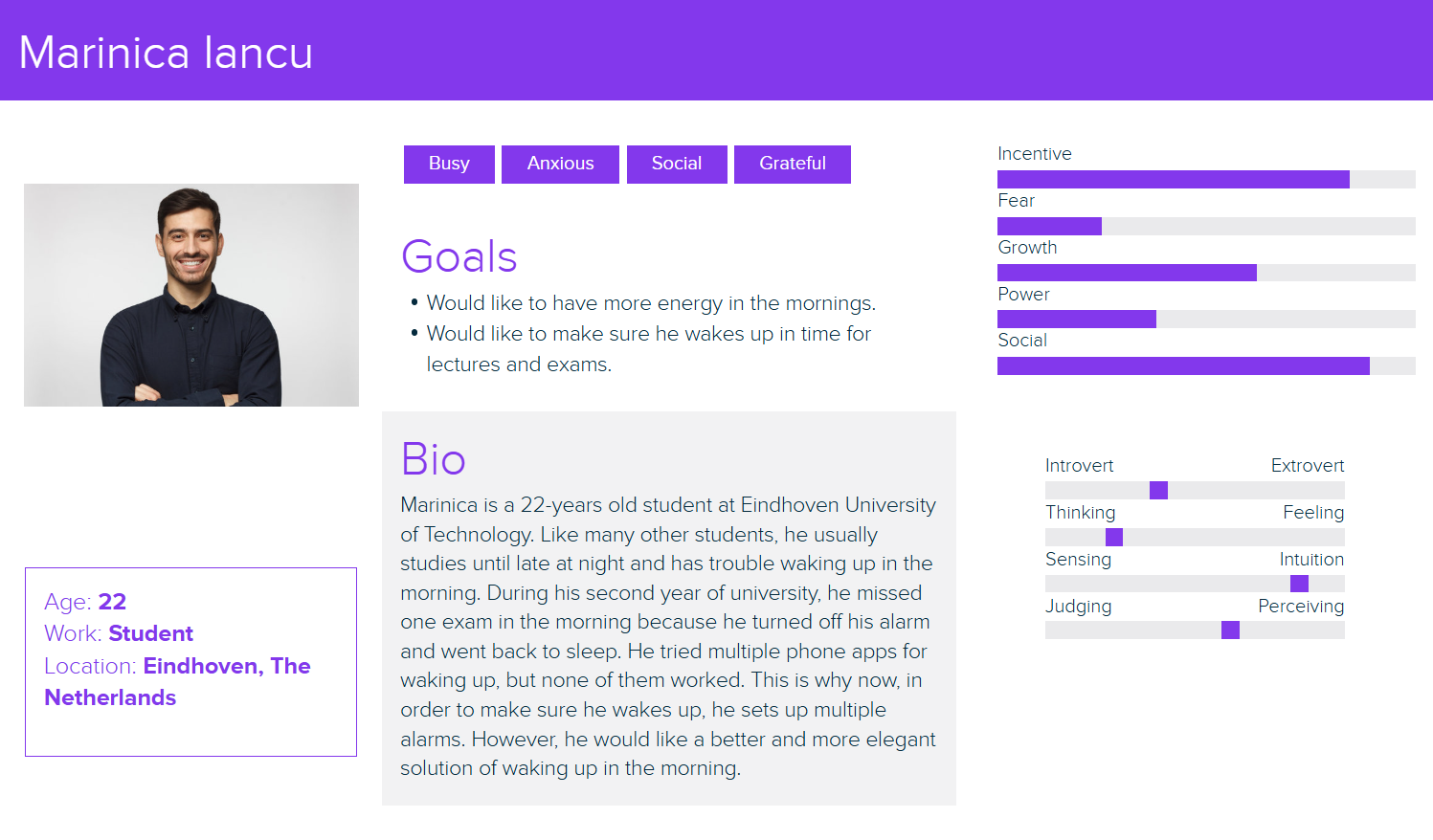
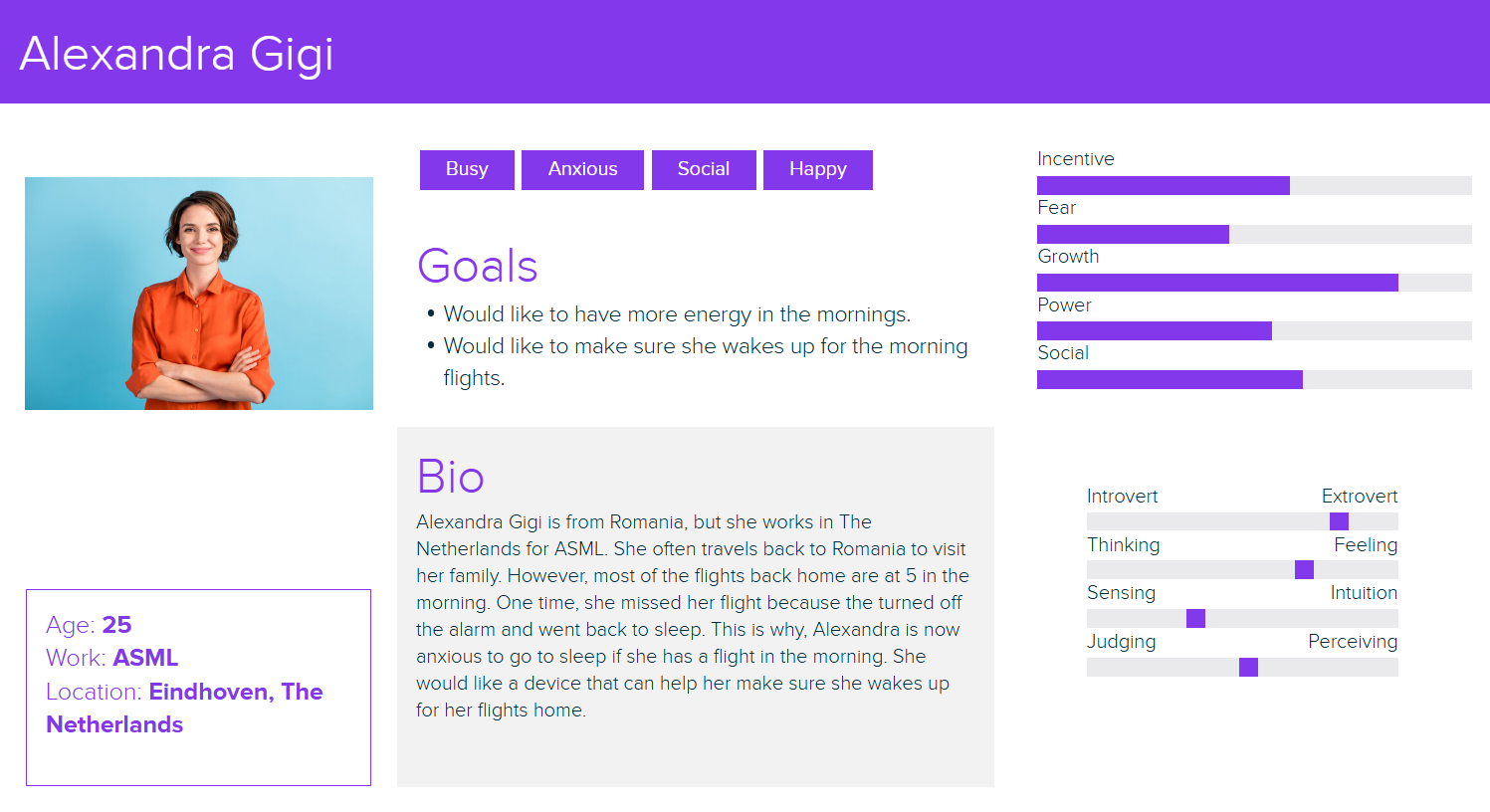
Product Requirements
| Id | Requirement Description |
|---|---|
| R-01 | The alarm clock shall be able to be programmed at what time it should wake up the user. |
| R-02 | The alarm clock time shall be able to be programmed by the user. |
| R-03 | The alarm clock shall be able to emit a sound loud enough to wake up the user. |
| R-04 | The alarm clock shall be able to be stopped by the means of the user exerting any kind of force agains an electromechanical device. |
| R-05 | The point at which the user's attempt to stop the alarm should be determined by the current draw to the electromechanical device. |
| R-06 | The user shall be able to set the maximum force the electromechanical device is allowed to exert. |
| R-07 | The alarm clock should be able to impose multiple cycles of the user overpowering the mechanical device. |
| R-08 | The alarm clock shall have a way of determining if the user has gone back to bed. |
| R-09 | The alarm clock shall keep track of user behaviour over time in order to maximise its ability to wake up the user and the experience of the user itself. |
| R-10 | The alarm clock shall be powered by the means of a main's connection. |
| R-11 | The overall alarm clock should not cost morethat 35 Euros. |
| R-12 | The user shall be able to provide feedback to the alarm clock in case of failure to wake up. |
| R-13 | The alarm clock shall have a time threshold after deactivation after which it will no longer check if the user is bed or not. |
| R-14 | The alarm clock threshold for stopping to actively check for the user's presence in bed should be able to be changed based on data accumulated by the system. |
Design
General Description
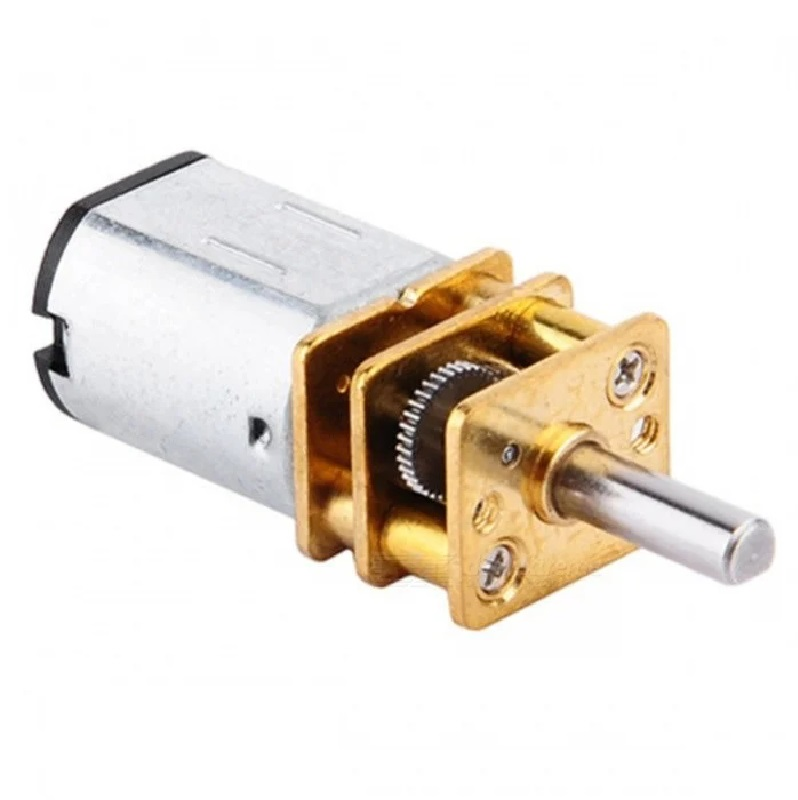
The important additions to a classical alarm clock that this design offers are represented in the way that the devices is able to actively check whether the user is in bed and its ability to adapt based on the user's behavior and the manner in which the alarm itself is turned off. Starting from the ground up, the first step was to move away from the simple motions used to turn off classical alarms, let them be in the form of a phone app or a more classical bedside digital/analog one. This was done in the form of having the user utilize a threshold amount of force in order to turn the alarm off. The intended result is to, once, reduce user anxiety in regards to the possibility of not waking up [1], and second, in order to raise the probability of the user having to be in a more awoken state in order to successfully turn the alarm off [3]. The next step was the introduction of a way in which the alarm clock can tell if the user has gone back to bed and act accordingly, based on previous data and negative user feedback.
Actuators
Speaker
The main role of the speaker is standard in the sense of an alarm clock, as it is used in order to generate a sound meant to wake the user up. The generated sound was chosen to be a 520Hz square wave signal due to the fact that: it is a simple sound which can be more accurately tested in an isolated environment and thus obtain a better appreciation for its efficiency in waking the user up and that from a multiple set of such sounds it is the one that offers the best performance in this context [5].
Micro-metal DC Motor
The motor is used, paired with a way to measure absolute positions (in this case a potentiometer), to provide the counteractive force in the "turning off" procedure of the alarm. An alternative would have been to use some kind of mechanical system to gauge user force, however with the need of commensurability of the amount of force threshold and the ability to emulate various kinds of haptic feedback through the feedback loop, the choice of using an electromechanical device in a closed loop system was chosen. A micro-metal DC motor with a 100:1 gear ratio was as a result of its compact form and output torque. The motor is connected to a potentiometer through a set of gears with a 1:1 gear ration. The force applied by the DC motor is controlled through a PWM signal generated by the internal computer/mictrocontroller. The nice simplicity of the setup is that the system in which the duty cycle of the input voltage is the input the output torque of the motor is the output represents a linear system. This can be deduced by first having the motor only apply static force (as that is how it is going to be used), thus the voltage drop over the motor winding will be 0.

This current through the motor is also directly proportional to the torque generated.

Since the current is also directly proportional to the duty cycle of the PWM signal, if the PWM signal is also controlled by a proportional controller then the force curve is going to be that of a spring. This is rather desirable as it provides good haptic feedback to the user and the device generating gradual torque is an indicator to the user that everything works as it should.
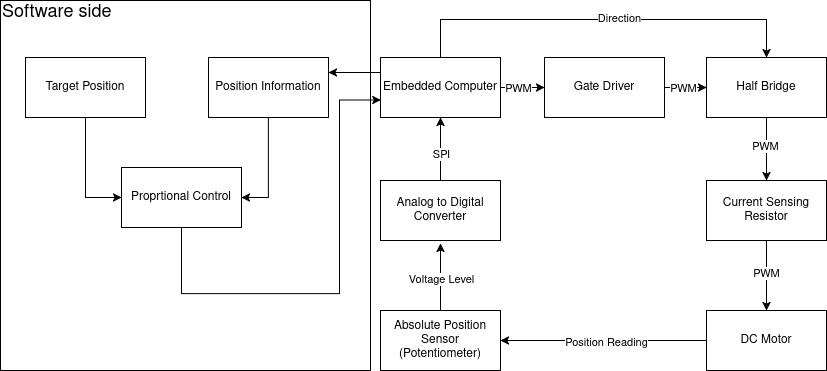
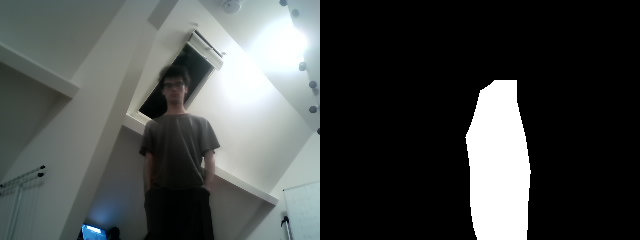
LCD Display
The LCD display is used in order to display the current time and display additional information in regards to what operation the user is performing a a certain moment, in relation to the device (setting a new alarm, feedback that the alarm has been deactivated etc.).
Sensors
The design features two main sensing inputs. The first one is a standard digital camera which will be pointed from above at the user's bed in order to check if the user is sleeping. This detection is done by first acquiring an image from the digital camera and using Tensorflow's BodyPix computer vision model to detect the visible sections of the user's body. The model does not require full vision of the entire human body and is able to detect sections of it. Note that this does however limit the probability of success of the measurement as it requires a minimal area of the user's body to be visible (e.g. such as the head), which may cause false negatives in the cases where the user is completely covered by the blanket. On the other hand the system should be quite resilient to false positives which have the capacity to worsen the user experience much more than compared with the false negatives. Furthermore, some geometrical analysis will be performed on the resulted detected areas. In such an analysis the content within the area is not taken into account but rather the size and shape of it.
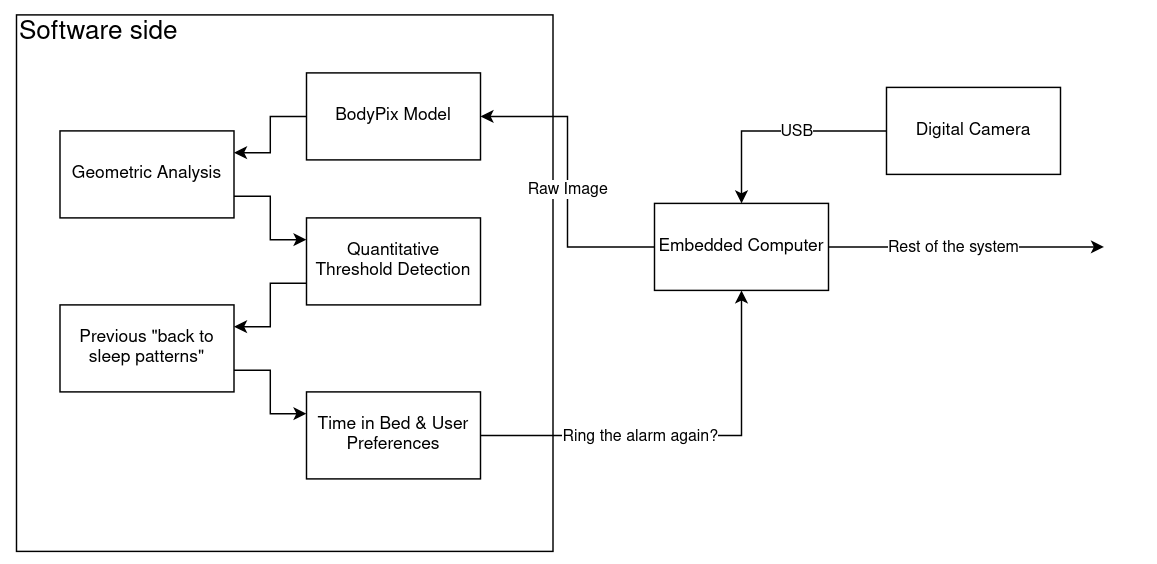
As displayed in the diagram above. The results of the detection are then used in relation to previous measurements, the amount of time the user stays in bed after the alarm has ringed and determines if the alarm should be turned on again to have the user leave the bed. By default the alarm clock waits 20 seconds after the alarm has been turned off to check whether the user has gone back to bed. The trade-off in the case of the time interval is in regards to not letting the user fall asleep for too much, in the event that they do go back to bed, and for the time interval not to be inconvenient, if one would have had to get out of bed in 3 seconds it would not be such a pleasant experience. The time interval is then changed based on how much can the user be trusted. If the device notices a track record of not going back to bed, or just not leaving it at all, then it try to increase this time interval. If the opposite is true, the user likes to go back to bed, then it will decrease this time interval.

Prototype Gallery
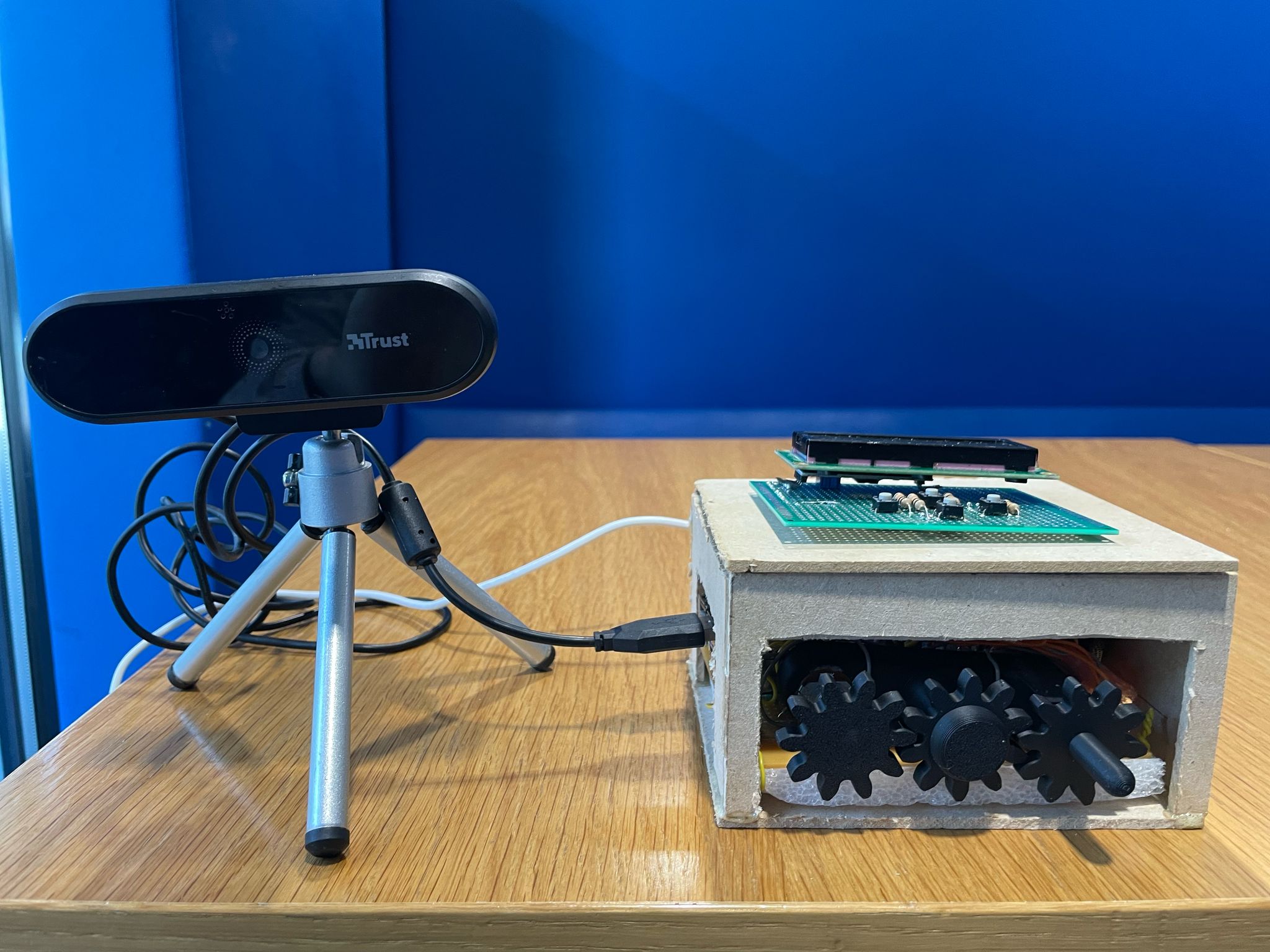
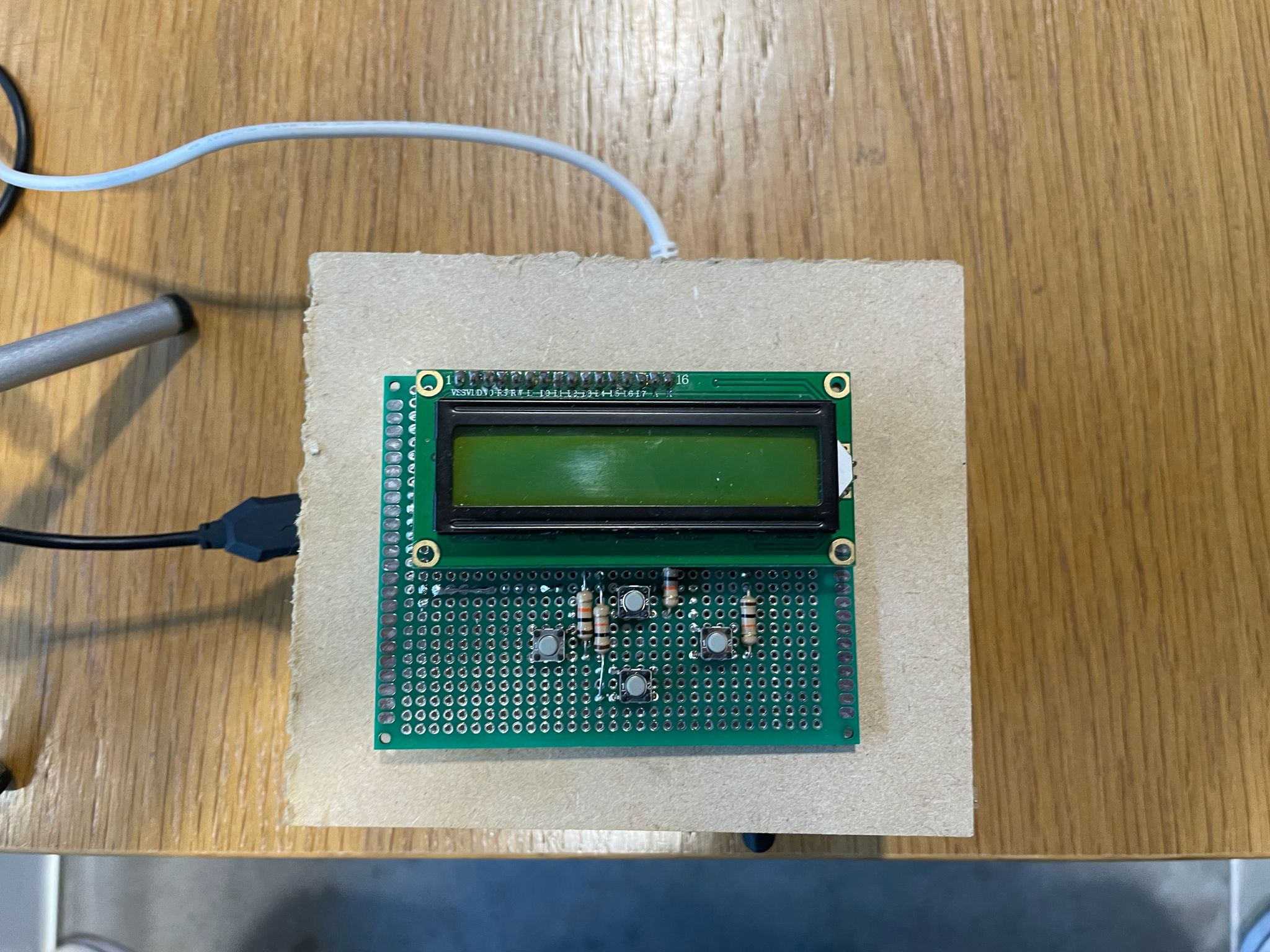
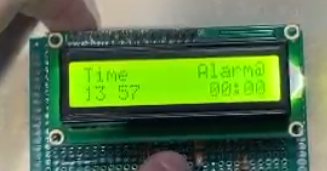
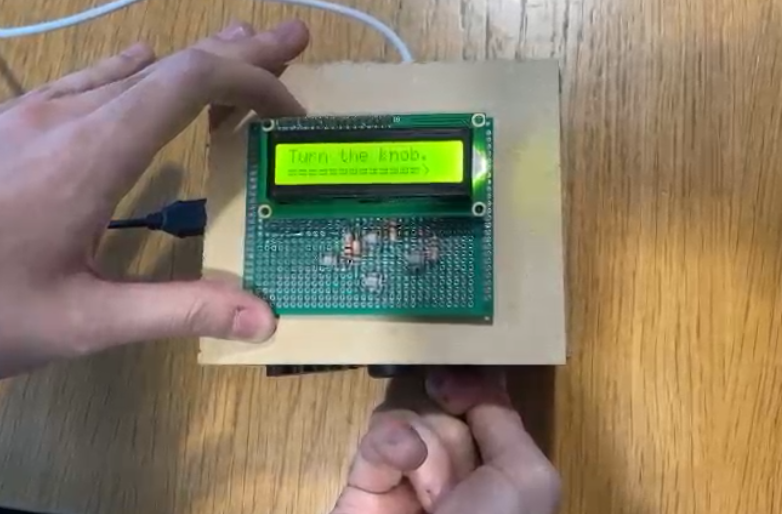
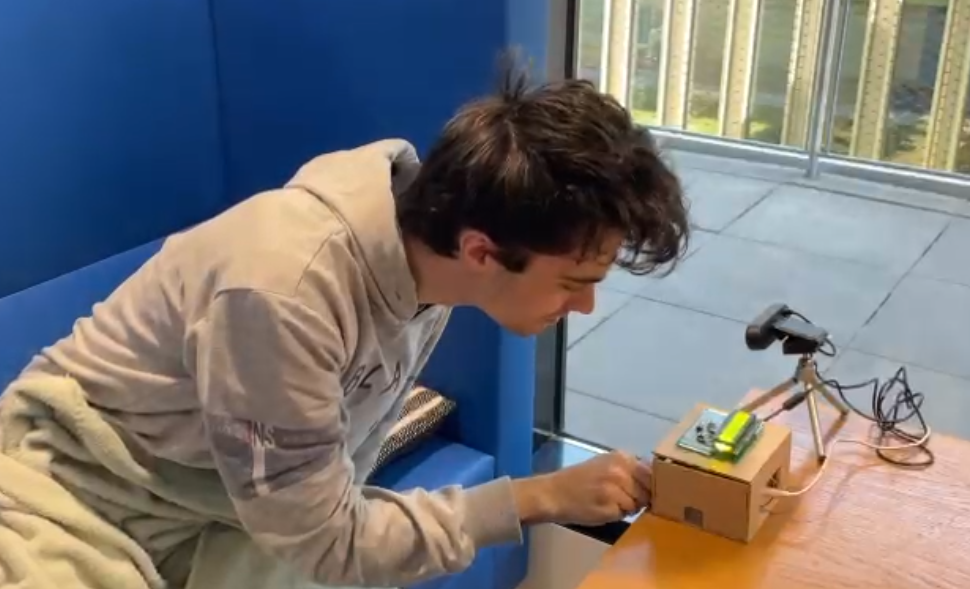

Experimental Results
| Point of Interest | Results |
|---|---|
| Sound effectiveness. | The sound is capable of waking the user up. However it seems to be quite an abrupt way of waking up. |
| Effectiveness of the knob. | The added effort in turning the alarm off does seem to a have some impact. The small excericse also increases blood flow in the hand that was used. |
| Effectiveness of the AI visual system. | The system did manage to determine if the person is in bed in most test scenarios. No actual cases of the user going back to bed have been recorded. There is also a type of "panopticon" effect present as the user actively knows that the device would normally monitor them afterwards. Furthermore, there were problems with a certain pillow pattern, more specifically if the pillow features a set of stripes then there is a chance that the model will classify that as a human body part. |
| Effectiveness of visual input. | The visual identifiers/feedback was understood by people who initially saw it for the first time. However the calibration procedure did impose some difficulties when using it for the first time. |
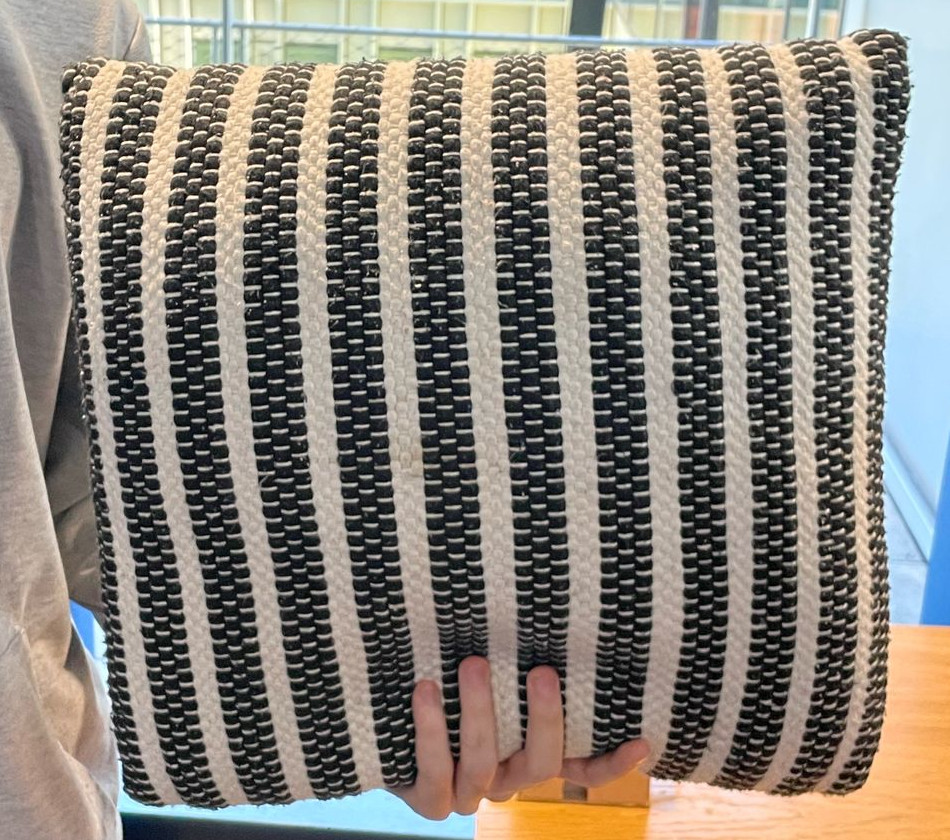
Future Improvements
A list of possible future improvements in future iterations.
1) A purpose built computer vision AI model would be required. One that was specifically trained on a relevant dataset. This is due to the fact that while the TfBodyPix model is capable of identifying body parts in an image, it is more so made to do it in more common environments where a person would be standing up, as opposed to lying in bed.
2) A normal camera is not well suited for this task as it requires a light source in order to operate. Moreover, if the user decides to put a blanket over them this also makes the task of the computer vision model much more difficult. Ideally a thermal camera would be employed as it can directly track the heat signature of the person in bed without requiring a light source or a direct line of sight.
3) The position reading device while working in the context of the prototype is not appropriate for the task as it limits the angles at which the knob can be rotated. A better approach would have been to use a servo motor absolute position encoder which does not limit rotation.
4) A DC motor, while offering the linear relation between torque and current, is susceptible to wear over time. Ideally a type of linear actuator or brush-less DC motor would be used in its place.
5) The user interface of the prototype is severely limited, it only offering just enough flexibility for testing purposes. A more modern/customizable choice can be made for its place.
6) The prototype is only capable of emitting one sound. This represents a limitation which could be easily overcome with future work.
7) The position sensor should be integrated within the actuator/motor for a more smaller design.
8) A real time clock should be implemented in order to keep track of time even if the device is unplugged.
9) A battery could be included in order to have the device still function in the event of a power outage.
10) A more gradual/calm alarm sound should be employed.
References
[1] Stephen M. Mattingly, Gonzalo Martinez, Jessica Young, Meghan K. Cain, Aaron Striegel, (2022), Snoozing: an examination of a common method
of waking, Sleep Research Society
[2] Keiko Ogawa, Emi Kaizuma‑Ueyama, Mitsuo Hayashi, (2022), Effects of using a snooze alarm on sleep
inertia after morning awakening, Journal of Physiological Anthropology
[3] PAUL R. JEANNERET, WILSE B. WEBB, (1963), Strength of grip on arousal from full night's sleep, Perceptual and Motor Skills
[4] Carolina Campanella, Kunjoon Byun, Araliya Senerat, Linhao Li, Rongpeng Zhang, Sara Aristizabal, Paige Porter, Brent Bauer, (2024), The Efficacy of a Multimodal Bedroom-Based ‘Smart’ Alarm System on Mitigating the Effects of Sleep Inertia, Clocks & Sleep.
[5] Dorothy Bruck, Ian Thomas, (2007), Waking effectiveness of alarm (auditory, visual and tactile) for adults who are hard of hearing
[6] Eino Hietanen, (1984), Cardiovascular responses to static exercise, Scandinavian Journal of Work Environment & Health
[7] Trotti, L. M. (2017). Waking Up is the Hardest Thing I Do All Day: Sleep Inertia and Sleep Drunkenness. Sleep Medicine Reviews
[8] Dinges, D. F., & Weaver, T. E. (2019). Sleep Inertia: Current Insights. Nature and Science of Sleep
[9] Russo, M. et al. (2023). The Danger of Grogginess: Sleep Inertia in Professional Settings. Clocks & Sleep
[10] McFarlane, S. J., et al. (2020). Alarm Sounds and Their Effect on Sleep Inertia.
[11] Maynard, D. et al. (2024). Chronotype, Wake Difficulty and Psychiatric Risk: A UK Biobank Analysis.
Work distribution
| Name | Week 1 | Week 2 | Week 3 | Week 4 | Week 5 | Week 6 | Week 7 |
|---|---|---|---|---|---|---|---|
| Stefan Baltac | 16 hours:
Studying research papers Updating the wiki page |
14 hours:
Studying research papers Writing interview questions |
16 hours:
Studying research papers Conducting interviews Updating the wiki page |
20 hours:
Analyzing the interview results Deciding the product requirements Designing and building the prototype Updating the wiki page |
20 hours:
Designing and building the prototype |
19 hours:
Designing, building and testing the prototype Updating the wiki page |
15 hours:
Working on the final presentation Filming demo Updating the wiki page |
| Octavian Astefanei | 15 hours:
Studying research papers Updating the wiki page |
16 hours:
Studying research papers Writing interview questions |
16 hours:
Studying research papers Conducting interviews Updating the wiki page |
19 hours:
Analyzing the interview results Deciding the product requirements Updating the wiki page |
14 hours:
Updating wiki page |
18 hours:
Designing, building and testing the prototype Updating the wiki page |
15 hours:
Working on the final presentation Filming demo Updating the wiki page |
| Kerim Gjergjizi | 12 hours:
Studying research paper |
10 hours:
Studying research papers |
14 hours:
Studying research papers Conducting interviews |
12 hours:
Analyzing interview results Deciding on product design |
12 hours:
Updating wiki Help on building the prototype |
16 hours:
Working on the final presentation Finishing up the wiki page |